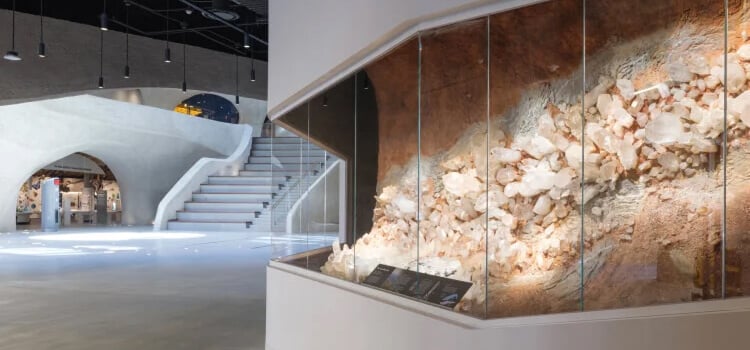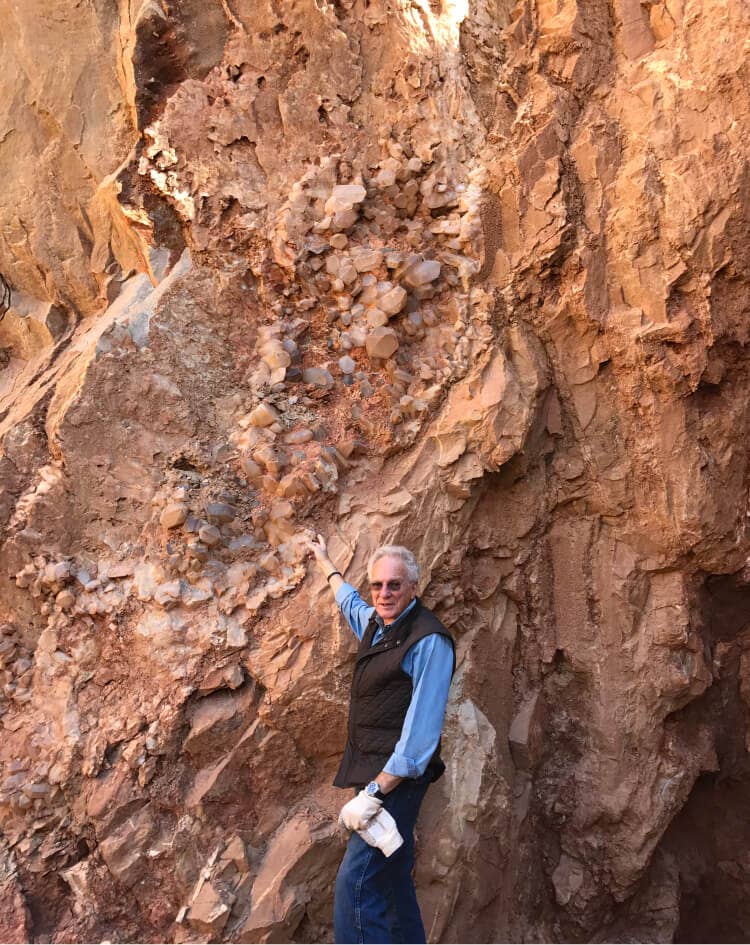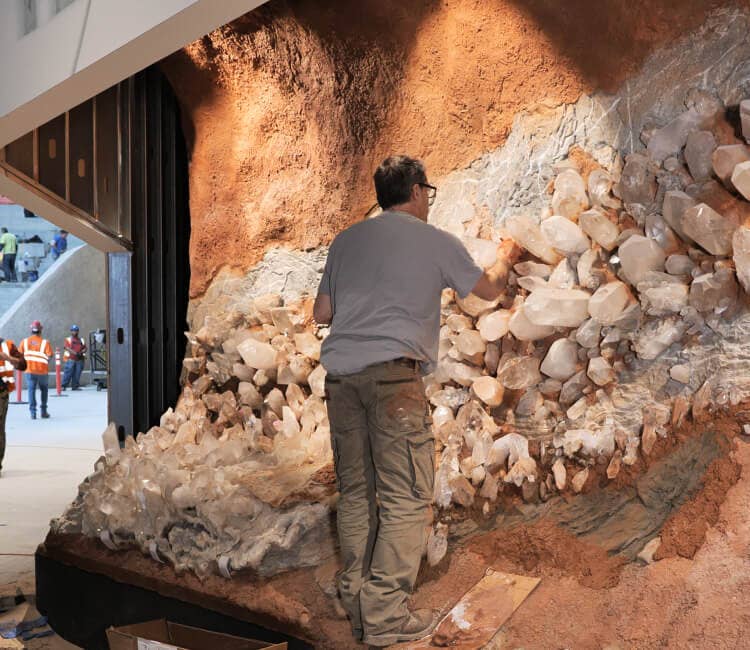1. David Yurman visits the mine in Blue Springs, Arkansas. 2. Evan Yurman unearths crystals at the source during excavation. 3. A work-in-progress look at the reconstruction of the quartz vein at the American Museum of Natural History.

Learn more about the Yurman Family Crystalline Pass at the American Museum of Natural History in New York City.

The Yurman family has always been inspired by stones of all kinds, and—unique for
a luxury jewelry brand—many of their designs celebrate the raw, imperfect beauty
of naturally occurring forms. David, Sybil, and Evan Yurman are honored to
announce the Yurman Family Crystalline Pass at the American Museum of Natural
History in New York City for the public to enjoy and learn from.
The Yurman family has always been inspired by stones of all kinds, and— unique for a luxury jewelry brand— many of their designs celebrate the raw, imperfect beauty of naturally occurring forms. David, Sybil, and Evan Yurman are honored to announce the Yurman Family Crystalline Pass at the American Museum of Natural History in New York City for the public to enjoy and learn from.
“So much of what we do is about framing the beauty of the earth, of what comes to us naturally.”
“So much of what we do is about framing the beauty of the earth, of what comes to us naturally.”
—SYBIL YURMAN
—SYBIL YURMAN
The Crystalline Pass connects the Museum’s renovated Allison and Roberto Mignone
Halls of Gems and Minerals to its new Richard Gilder Center for Science, Education,
and Innovation. Running the length of the Pass is a 19-foot-long installation
recreating a section of clear crystals from a remarkable, 70-foot-long mineral vein
found in the Ouachita Mountains of Arkansas. Rock crystal—the colorless,
transparent variety of crystalline quartz—grew in veins in the local sandstone, which
is riddled with large cracks that are coated with red, iron-oxide rich clay.
This region in Arkansas is famous for producing what many experts consider the
finest clear quartz crystal in the world, which has a long history of use, dating back
millennia. David Yurman has featured this rock crystal quartz, prized for its
durability and beauty, in his jewelry for years. The Yurmans were fortunate to visit the
mine during the crystals’ excavation. Digging quartz is a painstaking process that
takes many years, beginning with removing layers of topsoil and hard rock and then
carefully freeing the crystals by hand.
The Crystalline Pass connects the Museum’s renovated Allison and Roberto Mignone Halls of Gems and Minerals to its new Richard Gilder Center for Science, Education, and Innovation. Running the length of the Pass is a 19-foot-long installation recreating a section of clear crystals from a remarkable, 70-foot-long mineral vein found in the Ouachita Mountains of Arkansas. Rock crystal—the colorless, transparent variety of crystalline quartz—grew in veins in the local sandstone, which is riddled with large cracks that are coated with red, iron-oxide rich clay. This region in Arkansas is famous for producing what many experts consider the finest clear quartz crystal in the world, which has a long history of use, dating back millennia. David Yurman has featured this rock crystal quartz, prized for its durability and beauty, in his jewelry for years. The Yurmans were fortunate to visit the mine during the crystals’ excavation. Digging quartz is a painstaking process that takes many years, beginning with removing layers of topsoil and hard rock and then carefully freeing the crystals by hand.



F R O M T O P:
1. David Yurman visits the mine in Blue Springs,
Arkansas. 2. A work-in-progress look at the
reconstruction of the quartz vein at the American
Museum of Natural History. 3. Evan Yurman unearths
crystals at the source during excavation.
This awe-inspiring geological wonder is now something every Museum visitor can experience.
The quartz vein was recreated to appear as it first did when the crystals were first exposed.
Sculptural material was used to mirror the mine’s natural rock substrate—a dramatic, roughly
hewn backdrop for 4,000 pounds of dazzling crystals.
The Yurmans are delighted to support the creation of this exhibit at the American Museum
of Natural History, and to share their love of art, nature, and gemstones with the world.
This awe-inspiring geological wonder is
now something every Museum
visitor can experience. The quartz vein
was recreated to appear as it first did
when the crystals were first exposed.
Sculptural material was used to mirror
the mine’s natural rock substrate—a
dramatic, roughly hewn backdrop
for 4,000 pounds of dazzling crystals.
The Yurmans are delighted to support
the creation of this exhibit at the
American Museum of Natural History,
and to share their love of art, nature,
and gemstones with the world.
The Gilder Center’s exterior is clad in Milford Pink Granite and features rounded windows with bird-safe fritted glass.
The Gilder Center’s exterior is clad in Milford Pink Granite
and features rounded windows with bird-safe fritted glass.
Visitors enter into a five-story atrium modeled after geologic formations shaped by wind and water.
Visitors enter into a five-story atrium modeled after
geologic formations shaped by wind and water.
To reach program spaces, visitors traverse the building’s bridges, moving along sculpted edges and passing through vaulted openings.
To reach program spaces, visitors traverse the building’s
bridges, moving along sculpted edges and passing through
vaulted openings.
The Yurman Family Crystalline Pass recreates a 19-foot-long vein of crystal quartz found in the mineral-rich Ouachita Mountains.
The Yurman Family Crystalline Pass recreates a
19-foot- long vein of crystal quartz found in the
mineral-rich Ouachita Mountains.
Arkansas is known for producing some of the finest clear quartz crystal in the world.
Arkansas is known for producing some of the finest
clear quartz crystal in the world.
The Gilder Center establishes a west-facing entrance to the Museum and provides a connection to its additional 25+ buildings.
The Gilder Center establishes a west-facing
entrance to the Museum and provides a connection to
its additional 25+ buildings.